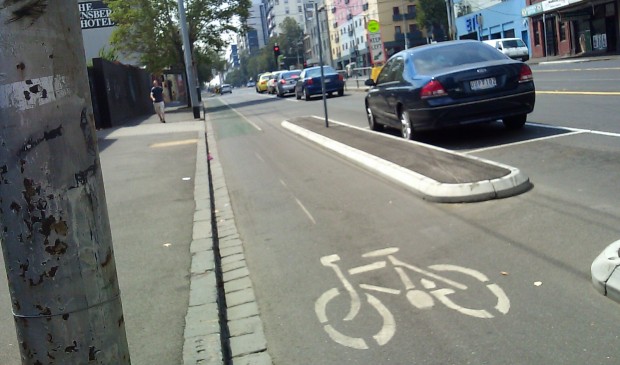Bike signal debate triggers acrimony at Council
Tuesday, February 17, 2015 by
Jenny Blair Some Austin City Council members grew irritated while debating the problems of bicycles at intersections and whether to accept grant money that could ease those problems at Thursday’s meeting.
At issue was a proposal that the Austin Transportation Department accept $200,000 in federal grant money already awarded by the Texas Department of Transportation to install bike-visible signals and bicycle detection equipment at 32 city intersections.
Asking about the item’s background and implications, District 1 Council Member Ora Houston asked, “Who thought this was a good idea?”
Transportation Director Robert Spillar told Council that existing traffic detectors at intersections don’t detect cyclists very well, so some cyclists grow frustrated and proceed illegally against the light. That puts cyclists and other traffic at risk. The proposed technology is intended in part to remedy that.
Other options for cyclists in this situation include pushing the pedestrian signal button or waiting in the road for a car to trigger the signal.
By Texas law, bicyclists may legally ride on city streets. They generally bear the same rights and responsibilities as motor vehicle operators.
In response to a question from Houston, Spillar clarified that the proposed technology would not prioritize bicycles the way smart signals do for priority buses.
“All we’re doing is the same thing that a pedestrian does when they push a pedestrian button. It simply says, ‘Hey, I’m here,’” Spillar said.
This particular grant has come up at least twice in recent years, but most Council members were voting on it Thursday for the first time. On Dec. 13, 2012, Council gave the department the go-ahead to apply for the federal grant. On June 26, 2014, Council authorized a funding agreement with the TxDOT to include a 20 percent local match.
Matched by $50,000 from the department’s FY 2014–15 capital budget, the $200,000 grant is to go into the department’s Operating Budget Special Revenue Fund. An additional $45,000 for design fees would come out of 2012 bond funds.
Houston asked whether it is illegal for bicycles to ride on the sidewalk in Austin. Spillar replied that it is not except for downtown, where the practice is discouraged and outright ticketable on some streets.
District 8 Council Member Ellen Troxclair asked why cyclists riding on sidewalks don’t simply push the pedestrian buttons.
Spillar explained that cyclists who clip into their pedals have a hard time reaching the buttons, and that moreover, the city does not encourage cyclists riding on the sidewalks.
The federally funded Pedestrian and Bicycle Information Center considers sidewalk-riding risky for cyclists who travel faster than pedestrians, partly because motorists tend not to expect to see cyclists on sidewalks. A New York State-funded review by Cornell University came to similar conclusions about the elevated risk of cycling on sidewalks.
Regarding a related project, Spillar told Council that the department is building a smartphone application for cyclists that would communicate with the traffic signal system, but still would not prioritize bicycles.
“These are all new technologies, and we’re trying to try multiple technologies out to see what’s best. … This really is a first-effort pilot to see what works best,” Spillar said.
District 6 Council Member Don Zimmerman told Spillar that his constituents are infuriated by traffic congestion and bicycle lanes.
“They keep getting told when they’re parked in traffic, ‘There’s no money, there’s no money for road improvement,’” Zimmerman said. “But there’s money for bicycle signaling. It drives people crazy.”
“The symbolism of this is actually a lot worse than just the money that’s being spent,” he added. “My regret is I can’t vote 10 times against it on behalf of the frustration of my constituents.”
Robin Stallings, executive director of BikeTexas, calls this type of ire from motorists a “bikelash.”
“Reallocating the space in the roadway to get a more efficient use of the right-of-way is a very good way to consider the needs of motorists … so that you get as much or more traffic flow than before,” Stallings told the Monitor.
“(Zimmerman is) a fiscal conservative, and he didn’t vote for the best congestion relief, and he didn’t vote for the best air quality, and he didn’t vote for the best quality of life,” Stallings continued. “And I believe that those are all things that he would care about if he had a better understanding of what this is about.”
Stallings added that BikeTexas looks forward to working with Council Members Houston, Troxclair and Zimmerman in advance of future bicycle-related votes to inform them of benefits to their districts.
The measure passed on an 8-3 vote, with Council Members Houston, Troxclair and Zimmerman voting against it.
Image by Barrylb (Own work) [Public domain], via Wikimedia Commons
You're a community leader
And we’re honored you look to us for serious, in-depth news. You know a strong community needs local and dedicated watchdog reporting. We’re here for you and that won’t change. Now will you take the powerful next step and support our nonprofit news organization?









